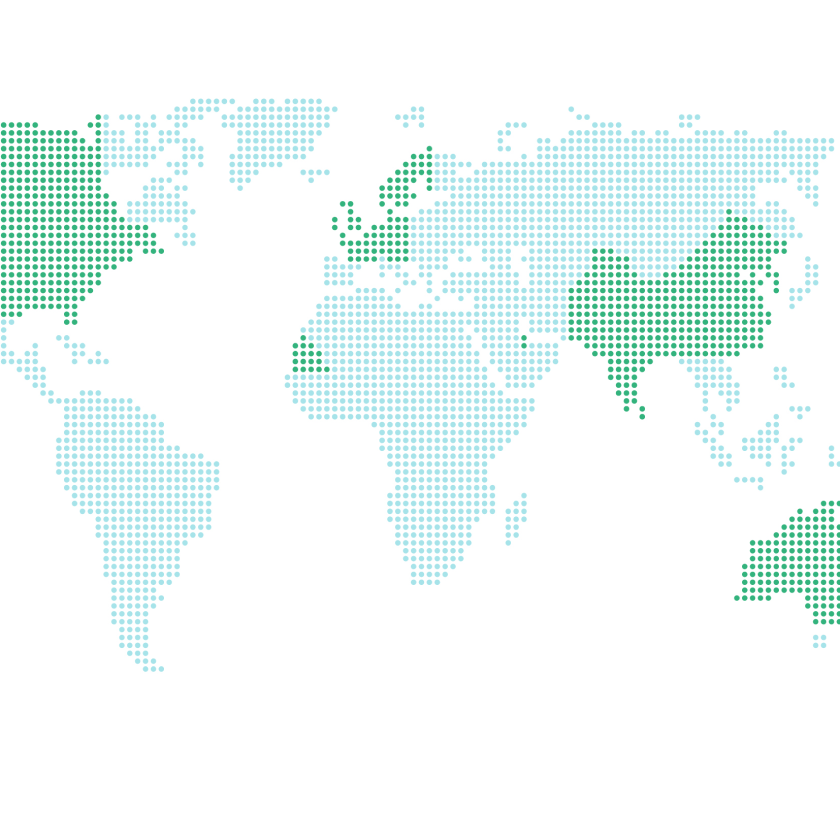Projects
Innovation in action: discover 27 initiatives across our networks!
As a partner to policymakers, Keolis places innovation at the heart of its corporate strategy to imagine the future of mobility, always in the service of passengers. Review a selection of initiatives launched in 2023 across our networks, presented during the Innovation Awards.
Without further ado, dive into our booklet and the selection of innovations for 2023: 27 initiatives to also find out about below!
Improving the passenger experience
Speak my language: multilingual public transport to make traveling easier
Difficulty understanding signs may discourage some people from using public transport. To remove this obstacle, the teams from Keolis Downer Adelaide in Australia came up with the idea of producing a podcast series called Speak My Language, which discusses issues relating to public transport. The podcasts are available in 11 languages and are tailored to a multicultural audience. Passenger service agents also wear badges showing which languages they speak in order to help passengers who don’t speak English to use the network.
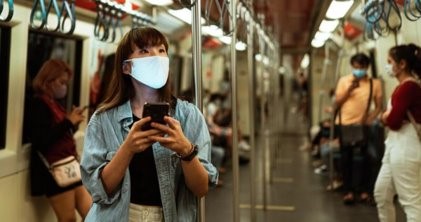
Augmented guidance: helping passengers find their way during improvement works
How do you minimize disruption for daily users of public transport while improvement works are being carried out? In Nancy, where trams stopped running along the main line for a year and a half, Keolis rolled out an augmented reality solution that passengers can access by scanning a QR code with their smartphone. The aim is to effectively guide passengers and help them find temporary stops. Harnessing users’ geolocation data, the solution maps out the route to the nearest stop. To make it even easier to understand, the route can be viewed on a 2D map or in augmented reality.
Improving management of ridership on the Lyon metro
To keep up with passenger comfort expectations, Keolis Lyon joined forces with the startup Affluences to trial a brand-new information system. Lights inform passengers waiting on the platform about how full each car is on the approaching train. Lights shine green when the car is relatively empty, orange when it is starting to fill up, and red when it is full. Using artificial intelligence, this system helps to better spread passengers along the platform and minimize the time needed to allow people on and off the train at each station.
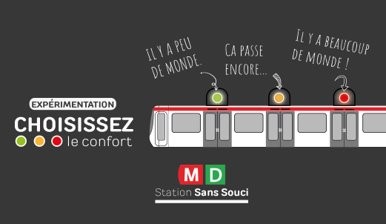
User-friendly badges to open ticket gates: contactless sensors for wheelchair users
Keolis is constantly testing new ideas to make public transport more accessible for all. For example, Keolis Rennes has put in place a system to help people with reduced mobility to use contactless ticket readers. A contactless sensor linked to their travel ticket can be attached to the right side of their wheelchair. As they come towards the ticket gate, their ticket is read and the gates open automatically! This solution follows the installation in 2016 of dedicated gates for wheelchair users, designed in collaboration with the local authority and several charities representing people with reduced mobility.
Easier access to public transport for older passengers
Older passengers may be discouraged from using public transport due to various concerns, such as not having enough time to board, the risk of having a fall, or finding no seats are available. To boost their confidence and empower them, Keolis Caen Mobilités put in place an innovative nudge system involving different markings along the passenger journey, from the station to priority seating, guiding users and encouraging other passengers to be considerate. Moreover, this innovation has helped manage passenger numbers among people with reduced mobility on the transport service.
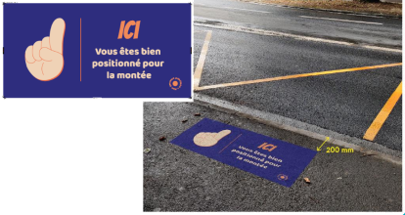
In brief...
- Ezymob: the Ezymob app developed by Keolis Besançon Mobilités helps blind and partially sighted passengers get about the network using artificial intelligence.
- Evelity: tested by Keolis and Sytral Mobilités in Lyon, the Evelity app helps blind and partially sighted passengers to find their way around metro stations.
- QR code : in Blois, to simplify travel and limit unintentional fraud, passengers can now buy and validate their tickets by scanning a QR code.
Keeping both passengers and employees safe
S-1 Gard Danger Zone Deflector: reducing the number of serious accidents
With the increasing use of bikes and scooters and distractions from smartphone usage, harmonizing different modes of transport calls for a shift in behaviors and enhanced measures to prevent severe accidents or fatalities. Keolis Sweden has fitted its buses with the S-1 Gard system, a polyurethane barrier attached to the chassis between the front and rear wheels, which prevents users from going under the bus in the event of a collision by pushing them away from the vehicle. The system represents a major step forward in terms of safety and will soon be rolled out on all Group buses.
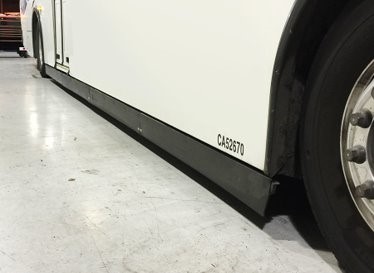
Cool Seal: improving comfort during heatwaves
In Australia, where temperatures regularly exceed 30°C, passengers and personnel at transport stops have no respite from the heat. In order to make them more comfortable, Keolis covered the ground with Cool Seal, which reflects the sun’s energy to produce cooler surface temperatures. Easy to apply, this solution also serves to protect the asphalt surface. Moreover, drivers noticed improved visibility at night as well as lower noise levels.
Exoskeleton: improving working conditions for maintenance employees
Keolis is keen to better understand and improve working conditions for employees. For example, in Tours, the company carried out an in-depth study of work-related musculoskeletal disorders. Several maintenance workers tested the use of exoskeletons, mechanical devices designed to reduce strain and fatigue by redistributing weight. The exoskeleton protects users’ shoulders and arms when work requires them to bear weight over their heads with their arms outstretched, which over time could damage their joint health. Workers appreciated the device, which helps in both primary and secondary prevention.
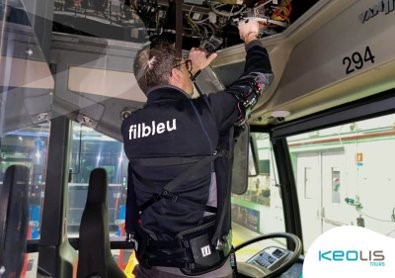
ADAS (Advanced Driver Assistance System): warning drivers of collision risks
Bus drivers travelling around the Lyon area can experience stress due to risk of collisions as vulnerable road users such as pedestrians and cyclists may not be seen in vehicle blind spots. To relieve this pressure, Keolis Lyon tested a new Advanced Driver Assistance System (ADAS). Several vehicles were equipped with a camera that films blind spots, sending the images for analysis by an algorithm. A visual and sound alert is automatically triggered in the event of there being a risk of collision. This system integrates AI capabilities and, unlike other systems, does not involve fitting the bus with additional, externally visible equipment. It has already cut the risk of accident and alleviates the mental load weighing on drivers.
In brief...
- Safety flash: to alert transport users of approaching trams, Keolis Bordeaux Métropole Mobilités put in place a visual flash system in addition to a gong sound.
- Real-time video: in the Greater Paris region, Keolis adjusted the video surveillance system installed on buses to improve monitoring of what is happening in real time.
- Toby: by asking Toby, the new HR chatbot, Keolis employees can instantly find answers to questions they may have on a variety of subjects, such as paid leave, compensation days for unpaid overtime, remote working and complementary health cover.
Optimizing network performance
CO2 Patterns: measuring the impact of mobility on the environment
The Group strongly believes that measuring public transport greenhouse gas emissions represents the first step towards achieving a more environmentally friendly mobility system. Its subsidiary Hove has developed Patterns CO2 in collaboration with Keolis Nancy and the consultancy Carbone 4. The system collects and analyzes anonymous GPS data to map journeys and modes of transport in a given zone in order to measure CO2 emissions and assess the effectiveness of decisions made by the urban transit authority, in particular with respect to infrastructure or the roll-out of low emission zones.
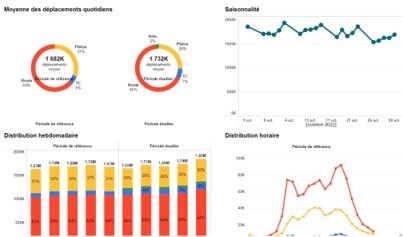
Smart Station: testing and presenting network solutions
The Keolis Group’s first Smart Station was deployed in Dubai with a view to developing and testing new innovations in mobility. This open innovation ecosystem brings together passengers, Group employees and new partners in the public and private sectors. The projects tested will help develop new solutions in four areas – passenger experience, operational experience, sustainable mobility, and health and safety. The concept, which has already facilitated five innovative projects, is due to be extended to other Keolis Group networks.
Impulse: network performance in an instant
The expertise Keolis has honed in both mobility and data analysis using AI has led to the development of Impulse, a system designed to analyze network performance. Impulse collects data from a variety of sources to analyze and share it with the public transport authority to foster relationships built on trust and transparency. The Impulse solution offers various levels of insights through a user-friendly interface: it provides a ‘weather’ overview of the network on a daily basis, a summarized view by theme (such as regularity, attendance, punctuality, etc.), and a thorough analysis of the network’s indicators.
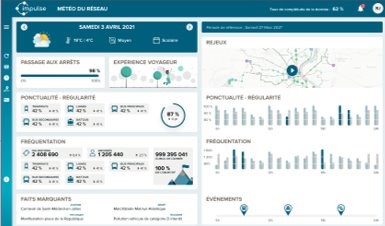
CAPTE: optimizing hybrid vehicle fleet management
The introduction of electric buses throughout a network significantly changes the way the vehicle fleet is operated and maintained. For example, the hybrid vehicle fleet requires battery monitoring, management of electric charging points and maintenance optimization. To respond to these emerging issues, the Keolis Amiens network rolled out the CAPTE solution to supervise the traditional buses as well as the 43 electric buses operated within the network and the charging points. The deployment of CAPTE illustrates the Group’s ability to implement accessible technical solutions to make on-board data systems easy to understand and thus optimize maintenance operations. Other use cases, such as eco-driving, will also be deployed to build on this solution.
Focus on... 3D printing: Keolis is constantly searching for innovative maintenance solutions, which is why it is closely monitoring the development of additive manufacturing laboratories. The Keolis Lyon, Keolis Métropole Orléans and Keolis Downer networks are now using 3D printing to produce parts and optimize the maintenance of vehicles. The main benefits of this approach include lower costs and shorter timescales compared with third-party suppliers. Using 3D printing also enables Keolis employees to acquire precious new skills and thereby bolster operational excellence.
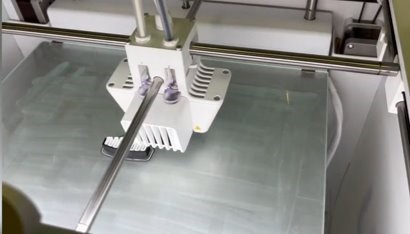
Ensuring environmental and operational excellence
Filgreen: involving drivers to improve network energy performance
Keolis Tours has perfectly understood that if the Group is to fulfill its targets relating to sustainable mobility, it needs to ensure drivers are actively involved. That is why they developed Filgreen, a “serious game” to involve Keolis Tours employees in the effort to cut the carbon footprint of the Filbleu network. By effectively harnessing data, artificial intelligence and gamification, drivers and their managers can take part in a unique experience structured around collective targets and individual objectives. After the first year, which focused on eco-driving, the game will introduce new focus areas such as customer relations, without losing sight of the aim of celebrating success and achieving individual and collective targets.
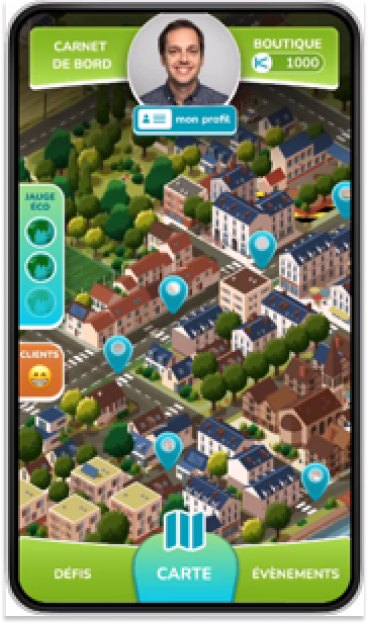
Bioteos: improving air quality in the metro
The Group has made it a priority to develop innovations that improve air quality. In northern France, Keolis Lille and the Métropole Européenne de Lille have conducted a study to measure air pollution in its metro stations and trains. Following this study, the Group tested two air treatment solutions designed to reduce passenger exposure to fine particulate matter. The first solution involves treating the captured air using microalgae, while the second uses a sodium solution. The results, which were broadly similar across the two solutions, showed a significant reduction in fine particulate matter on station platforms. The microalgae solution received a very strong approval rating among passengers thanks to its design and innovative nature. It is also very easy to maintain and consumes relatively little energy.
TRES (Train Examination System): automatic maintenance and data collection
Keolis MHI has been testing TRES (Train Examination System), a cutting-edge automated robot equipped with a series of LiDAR sensors (combining lasers and a high-resolution camera) as well as a system to visualize and analyze data. Rolled out in Dubai, TRES can inspect trains autonomously, collect and analyze data, as well as make recommendations and forecasts regarding future maintenance.
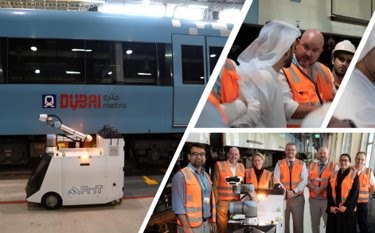
Keinfo: leveraging generative AI to improve passenger information
When disruptions occur on a transport network, priority must go to informing passengers and providing alternative mobility solutions. In the Netherlands, Keolis Nederland has developed a generative AI tool able to produce passenger information messages tailored to different communication channels (social media, website, mobile app, etc.). Automating the generation and publication of messages saves time and minimizes the disruption and stress experienced by passengers when problems arise.
In brief...
- Laser detection: Keolis Shanghai deployed an automated robot to maintain the tracks along the Pujiang line.
- Keodrive: Keolis North America has developed an innovative program to encourage its drivers to reduce energy consumption.
- Maintenance 4.0: Keolis Manchester tested a solution to monitor the overhead lines powering its tram network in order to prevent network incidents.
We’re not just talking about innovation, we’re doing it
Every year, new innovations emerge within each one of our affiliates and business divisions. During our Innovation Week and Innovation Awards in late January 2022, we received no fewer than 135 innovation project applications.
Originating from 15 countries in which the Group is present, these innovations all respond to on one of our 4 commitment pillars: Our People, Our Passengers, Our Planet and Our Partners (Public Transport Authorities).
Whether disruptive or incremental, each innovation offers concrete solutions to operational challenges that public transport networks face every day.
